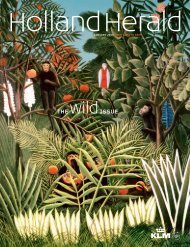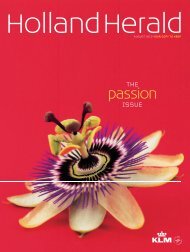january-2012
january-2012
january-2012
Create successful ePaper yourself
Turn your PDF publications into a flip-book with our unique Google optimized e-Paper software.
TRAVEL BRAZIL<br />
“ There’s no big city in the world that offers<br />
such wonderful jungle-trekking ”<br />
On the northern corner of Praça General Osório is<br />
Amazônia Soul, a tiny restaurant that specialises in the culinary<br />
delights of the jungle. Th ere is the tangy tacacá soup, fl oating<br />
with globs of ‘tapioca glue,’ and vatapá (fi sh with coconut milk,<br />
prawns and fl our), served with boiled jambo. Th is plant is<br />
famous in Brazil for the bizarre way in which it renders the<br />
mouth numb.<br />
Aft er dinner, Gustavo, Amazônia Soul’s enthusiastic young<br />
manager, might off er a small glass of jambo liqueur. “It’s only<br />
mildly alcoholic,” he says, “but the eff ect is like an orgasm for<br />
your tongue.”<br />
Th e description seems like hyperbole, but when you can<br />
fi nally talk again – eyes glazed and tongue quivering – it<br />
becomes clear there is no better way to describe the experience.<br />
Th e speciality of the house though is açaí, the Amazonian<br />
‘super-fruit’ sought aft er by athletes and bodybuilders that is<br />
usually served as a sweet, chilled puree. It is hard to believe that<br />
something so delicious can be so healthy.<br />
If Rio de Janeiro were a person, then Ipanema would be a<br />
pair of strong, tanned legs and the hilltop quarter of Santa<br />
Teresa, with its lush gardens, would take in the vital organs all<br />
the way from the lungs to the brain.<br />
Th is neighbourhood rises out of the hot-blooded Lapa<br />
quarter (which, with its permanently swaying samba<br />
soundtrack, might well be Rio’s hips).<br />
Santa Teresa is the city’s bohemian and artistic centre and is<br />
the best place to take in Rio’s art scene, whether in formal<br />
galleries or through vibrant street-graffi ti.<br />
On Saturdays, Cariocas from all over the city come here to<br />
eat the delicious feijoada stew – a delicious explosion of pork<br />
and beans. Others come simply to sip caipirinhas made with<br />
cachaça (sugarcane spirit) mixed with limes and guava, mango<br />
or pineapple.<br />
Sobrenatural is a Santa Teresa institution, famed for its<br />
seafood: you might not be tempted by the bizarrely named<br />
punheta de bacalhau (roughly ‘masturbation of cod’), but grilled<br />
surubim fi sh with coconut milk is unforgettable served with<br />
‘Brazilian banana, Brazilian potato and Brazil nuts’.<br />
Rio remains a jungle city, and nowhere is this more evident<br />
than in Santa Teresa, where decadent old colonial mansions<br />
stand as the fi rst barricades in a never-ending battle against<br />
encroaching nature.<br />
Parrots squawk in the treetops, ferns force their shoots<br />
through the cracked walls, and bromeliads send down aerial<br />
roots from the overhead tram cables.<br />
In the garden of the lovely Cafecito Café, you can almost<br />
hear the lush tropical vegetation growing. It’s like the jungle is<br />
waiting to reclaim the cobbled alleys.<br />
And immediately beyond Santa Teresa, the jungle does take<br />
over. Rio is home to the world’s two biggest urban rainforests,<br />
and the phrase ‘concrete jungle’ takes on a new meaning.<br />
Holland Herald 55

















